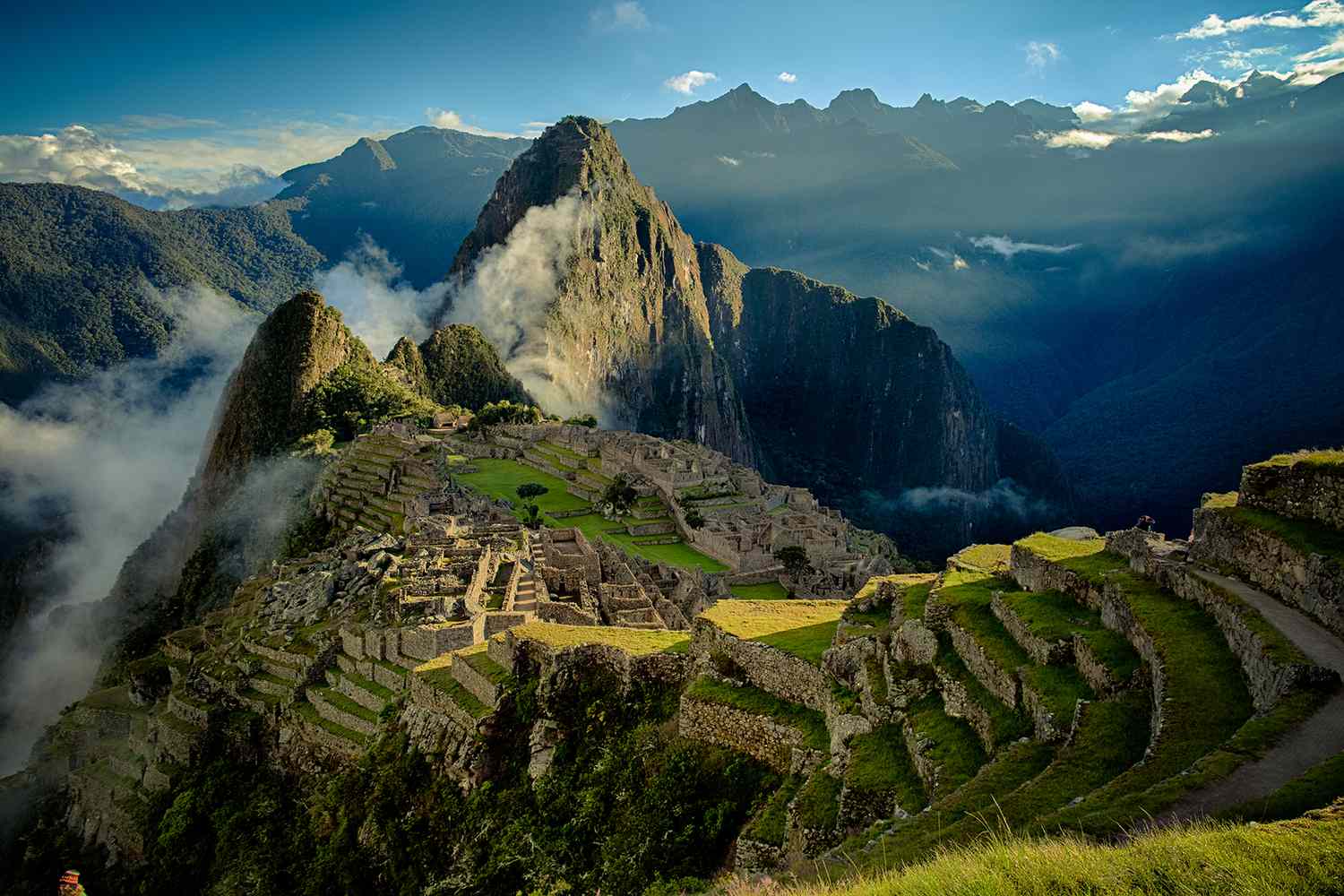Adventure vacations provide an opportunity to understand a place on a deeper level while also testing the limits of your body and mind. You get to know the ocean by diving in it alongside apex predators, and you get to see the most elusive dwellers of the Guatemalan jungle by joining them in the treetops on a canopy tour.
Plus, a thrilling experience makes the trip unforgettable, whether it’s swimming with great white sharks or jumping out of a plane. You’re bound to leave your destination with a story to tell. Not usually the daredevil type? No problem — these 10 adrenaline-packed trip ideas to be beginner-friendly, accessible, and, most importantly, fun. Buckle up.
Paragliding Over Italy’s Apennine Mountains
The village of Castelluccio, in Italy’s Umbria region, sits about three hours from Rome. Perched high on a grassy hill, it’s known for providing stunning views over the Piano Grande, a valley that comes to life with thousands of tiny red, white, and purple flowers every spring (there’s even a festival that celebrates the superbloom every summer). It’s the perfect place to soak up fresh mountain air while indulging in the region’s notable pecorino cheese.
It’s also a paraglider’s dream. At 8,123 feet in the air, Monte Vettore is the typical jumping-off point for a 20-minute tandem glide with Fly the Appenines. (If you’re hungry for more air time, you can also sign up for longer 90-minute cross-country flights.) Piano Grande’s year-round mild weather makes it ideal for this activity, so even if you show up after the flowers have faded, you’ll still be in for a treat. Once you’re back on the ground, there’s still the rest of Umbria to explore by foot, car, or even on horseback.
Heli-skiing in the Alps
It’s no secret that the Alps are home to world-class skiing. But for those who want exclusive access to untouched powder and secluded wilderness, there’s nothing like a heli-skiing trip to make you feel like the mountains are your own private playground. At the northern edge of Piedmont, Val Formazza offers all the isolation you’ll need.
The protected valley is surrounded by three majestic peaks: Ofenhorn, Blinnenhorn, and Basòdino. And because it’s so high up (the highest landing spot available is around 10,500 feet), snow falls by the feet every year. To access all that unspoiled backcountry, Heli-Guides maintains a fleet of Airbus AS 350 helicopters, and the menu of options — from easy day trips to full-week packages — means travelers can spend as much (or as little) time in the valley as they like.
Of course, some prior skiing experience is needed, but you don’t have to be a pro. Guides choose from a wide range of landing spots, meaning they can customize the trip to match your exact level of ability. And one thing’s for sure: wherever you choose to land, the views aren’t likely to disappoint.
Diving With Great Whites in South Australia
Off the coast of Port Lincoln in South Australia, the Neptune Islands are home to Australia’s largest colony of long-nose fur seals. And while those cuties are worth a visit themselves, what interests thrill-seekers are their top predator: the great white shark.
Little is known about the migration habits of great white sharks, which is what makes this site so exciting for adventure travelers. Thanks to a mingling of cold and warm currents merging from the Indian and Southern Oceans, the islands offer an incredible diversity of wildlife, hence the appeal for bloodthirsty sharks.
Humans aren’t on the menu, of course. Companies like Calypso Star Charters keep you safe inside a steel cage or what’s known as an “aqua sub” (essentially a reverse aquarium, where the fish are outside the glass). You’ll be free to marvel at these 19-foot-long beasts as they swim within arm’s reach.
Hiking From Hut to Hut in the Colorado Backcountry
Little-known fact: Colorado is home to more huts and yurts than any other state in the U.S. And that’s not by accident. Back in the ’80s, members of the 10th Mountain Division of the U.S. Army decided to recreate the huts they’d encountered while on duty in the Alps. And so the 10th Mountain Division Hut System was born.
Today, the network of 38 huts spread across a 350-mile route gives travelers a chance to connect with the Colorado wilderness. Just don’t come expecting turn-down service. The huts are rustic — you’ll have snowmelt for water, a bare bed, and basic cooking utensils, and that’s about it. But for all the austerity, the huts have a zen-like appeal (and they’re very affordable). Some are close to popular trails, while others are miles (and we do mean miles) from civilization.
Best of all, you can go any season. Just be prepared to sweat. In winter, it could be six or seven miles of cross-country skiing to get from one hut to the next. (Intermediate skiing skills are required.) And in the summer, it’s the same distance for hiking and mountain biking — just without the snow. However you do it, make sure at least one person in your group has wilderness experience, not to mention avalanche safety training for winter visits. As the website states: “Route finding may be the most important skill you’ll need.”
Hiking Around Red-hot Lava in Hawaii
Each day, hundreds of people show up to Hawaii Volcanoes National Park to witness the plumes of gas and steam; by night, the phenomenon is even more spectacular, as you’ll see red-orange lava glowing from inside the rim of the caldera. The sight is enough to make you realize the sheer geological power of Hawaii’s subterranean stirrings. And the trip is entirely family-friendly: On a 12-hour guided tour with Hawaii Forest & Trail, you’ll embark on a hike around the park, go romping through a dark lava tube, and enjoy views of the flowing lava from several key vantage points. Nature doesn’t get any more thrilling.
Snorkeling in Belize
Taylor McIntyre/Travel + Leisure
Belize’s Great Blue Hole is not only one of the most mysterious — and beautiful — sites on Earth, it’s also a must-visit destination for divers. Venturing all the way down is recommended for experienced divers only. But that doesn’t mean the rest of us can’t go exploring, too.
Snorkeling is a fun, beginner-friendly way to glimpse life below the surface. On Belize’s largest island, Ambergris Caye, an area called Tres Coco is a wonderful place to start. Here, snorkelers benefit from large brain and elkhorn coral in waters that only about four to eight feet deep. You’ll see not only tropical fish like yellowtail snapper and rainbow parrotfish, but also conch, banded shrimp, sea urchin, and stingrays.
A few miles off the southern tip of Ambergris Caye, you’ll find Hol Chan Marine Reserve, another excellent destination for underwater thrills. The protected reserve is teeming with wildlife, including a sandy-bottom area that’s become a gathering place for nurse sharks, hence the name: Shark Alley. Don’t worry, though. Despite the sharks’ intimidating appearance and rows of serrated teeth, they’re harmless to humans, and will only respond aggressively if provoked.
Walking in the Treetops of the Guatemalan Jungle
If you’re not afraid of heights, a visit to Guatemala’s Tikal National Park might be in order. The UNESCO World Heritage site is best taken in from the treetops on a canopy tour, one popular thing to do in the park.
On one of these tours, you’ll soar through the jungle via zipline. The route connects multiple platforms built about 100 feet above the forest floor, and it offers an impressive bird’s-eye view of the flora and fauna. Along the way, naturalist guides will be able to identify any creatures — howler monkeys, ring-tailed coatimundi, jaguars, and toucans, to name a few — that catch your eye.
While you’re here, stick around to explore the park’s impressive Mayan ruins. Scattered throughout the park is a network of 3,000 ancient temples, monuments and dwellings — the largest excavated site in the Americas.
Climbing up Half Dome in Yosemite National Park
Valerie de Leon/Travel + Leisure
America’s national parks are full of enchanting scenery, but nothing quite compares to the magnificent peaks of Yosemite Valley. The sheer granite cliffs appear to poke the heavens, while the gently cascading 2,400-foot waterfalls will make you think you’ve wandered straight into Neverland. For a truly unforgettable panorama, hike up Half Dome, one of the park’s most recognizable monoliths.
Only 300 hikers are allowed to hike the trail each day. And when you start making your way up the near-vertical rock face, you’ll understand why. A steel cable acts as a handrail, with a series of wooden slats for your shoes to grip onto. Due to the treacherous nature of the climb, things move very slowly, as folks do their best to advance up the rock without tumbling into the valley below. (Don’t forget: The route is two-way, so you’ll also have to navigate sharing the cables and foot rests with all the folks climbing down, too.)
To apply for a climbing permit, you have to enter the park’s lottery in March, before the season starts. A limited number of permits are available on a first-come, first-serve basis; those can also be secured through the website. Don’t forget to drink water while you’re out there — and lots of it.
Trekking to Machu Picchu
Rory Fuller/Travel + Leisure
If the idea of trekking through a stark landscape of craggy mountains and lush jungle sounds appealing, then maybe it’s time you finally crossed Machu Picchu off your wish list.
A colorful mix of landscapes awaits hikers on the Salkantay trek, a pleasantly crowd-free alternative to the popular Incan Trail that leads to the archaeological wonder. The classic five-day itinerary begins with scaling Salkantay mountain, the 12th highest in Peru. It’s hard work, but the endorphins greeting you at the top of the pass — not to mention those views — will be reward enough. From there, it’s onto the delights of the Sacred Valley’s “cloud forest,” where you’ll cross under waterfalls, go zip lining, and sleep in yurt-like tents with all meals catered by a team of guides.
By the time you finally reach Machu Picchu (at sunrise, no less) on the fifth day, it’ll feel less like a wish-list item and more like the natural continuation of a landscape which, after sleeping outdoors and sharing meals with locals, you’ll likely feel connected to. Enjoy the view from the top, you’ve earned it.
Skydiving Over Dubai
Dubai might not be the first place that springs to mind when you think of adventure. The desert metropolis is typically associated with glamorous hotels, gold, and its iconic skyscraper, Burj Khalifa. But for those looking to skip the malls, skydiving is a fun way to see another side of Dubai — literally.
Picture this: You’re freefalling at 120 miles an hour, having been dropped out of a plane 13,000 feet over Dubai. Below you, the famous Palm Islands are spread out like a painting made of sand. From above, you’ll be able to make out the turquoise Persian Gulf, the symmetrical “fronds” of the islands, and the spiral structures that mark the Dubai skyline.
You’ll be strapped to an instructor, of course. (Someone’s got to make sure that parachute deploys!) After freefalling for 60 seconds, you’ll float slowly over the city for five minutes, and between the views, the howling wind, and the pleasant feeling of weightlessness, the sensory overload will leave you grinning ear to ear. By the time you touch down, you’ll probably want to toast your bravery with a glass of bubbly. Looks like that hotel bar will come in handy, after all.










